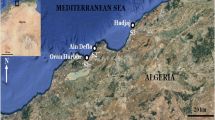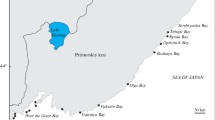Summary
The accumulation and physico-chemical forms of metals were determined by atomic absorption spectrometry in the whole soft tissues of oysters, by histological and microanalytical techniques in tissue sections, by gel permeation chromatography of soft tissue homogenates. Oysters were reared according to four types of experimental conditions: exposed to silver (20 μg Ag/l) or unexposed, in sea water (33‰) or brackish water (8‰). Copper, zinc and silver accumulation in oysters are inversely related to salinity. Amoebocytes, which play a key role in accumulating copper and zinc in natural sea water, are able to sequester an important part of added silver as Ag2S. In brackish water an increase of the number of amoebocytes may be considered as responsible for the enhancement of Cu and Zn concentrations in the whole soft tissues. In such conditions, additional silver is concentrated in these cells rather than in the basement membranes which are target structures for Ag2S accumulation in sea water. If the global fluctuations of metal concentrations in the soft tissues are ascribable mainly to changes at the histological level, the fate of metals in the soluble fraction must not be neglected since the speciation of metals influences their toxicity. The freshening of sea water induced a change in the distribution of cytosolic silver and zinc but in no case were the molecular masses of compounds associated with each metal perfectly identical. From these results, it is concluded that the accumulation of silver by oysters is not mediated by the same mechanisms as those for copper and zinc.
Similar content being viewed by others
References
Amiard JC, Pineau A, Boiteau HL, Métayer C, Amiard-Triquet C (1987) Application de la spectroméetrie d'absorption atomique Zeeman aux dosages de huit éléments traces (Ag, Cd, Cr, Cu, Mn, Ni, Pb et Se) dans les matrices biologiques solides. Water Res 21:693–697
Anon. (1980) Trace metals. Publ Natl Acad Sci. Wash DC 3:78–132
Berthet B, Amiard-Triquet C, Martoja R (1990) Effects chimiques et histologiques de la décontamination de I'huîtreCrassostrea gigas Thunberg préalablement exposée à l'argent. Water Air Soil Pollut 50:349–363
Bowen HJM (1985) The cycles of copper, silver and gold. In: Hutzinger O (ed) The handbook of environmental chemistry, vol 1. Springer-Verlag, Berlin, pp 1–27
Bryan GW, Langston WJ, Hummerstone LG, Burt GR, HO YB (1983) An assessment of the gastropod,Littorina littorea, as an indicator of heavy-metal contamination in United Kingdom estuaries. J Mar Biol Assoc UK 63:327–345
Cain DJ, Luoma SN (1985) Copper and silver accumulation in transplanted and resident clams (Macoma baltica) in South Francisco bay. Mar Environ Res 15:115–135
Calabrese A, Gault E, Thurberg FP (1982) Effects of toxic metals in marine animals of the New York Bight: some laboratory observations. In: Mayer GF (ed) Ecological stress and the New York Bight. Estuarine Research Federation, Columbia SC, pp 281–297
Calabrese A, McInnes JR, Nelson DA, Grieg RA, Yevich PP (1984) Effects of long-term exposure to silver or copper on growth, bioaccumulation and histopathology in the blue musselMytilus edulis. Mar Environ Res 11:253–276
George SG, Pirie BJS, Cheyne AR, Cooms TL, Grant PT (1978) Detoxication of metals by marine bivalves: an ultrastructural and biochemical study of the compartmentation of copper and zinc in the oysterOstrea edulis. Mar Biol 45:147–156
George SG, Pirie BJS, Calabrese A, Nelson DA (1986) Biochemical and ultrastructural observations of long-term silver accumulation in the mussel,Mytilus edulis. Mar Environ Res 18:255–265
IAEA (1987) Intercalibration of analytical methods on marine environmental samples. Progress report n°34; pp 1–27, International Atomic Energy Agency, Vienna
IAEA (1988) Ibid. Progress report n°36, pp 1–7
Martoja M, Truchet M (1991) Etude histoanalytique de l'intoxication par l'argent chez deux mollusques d'eau douce,Dreissena polymorpha etViviparus viviparus. Vie Milieu 41: in press
Martoja R, Ballan-Dufrançais C, Jeantet AY, Gouzerh P, Amiard JC, Amiard-Triquet C, Berthet B, Baud JP (1988) Effets chimiques et cytologiques de la contamination expérimentale de l'huîtreCrassostrea gigas Thunberg par l'argent administré sous forme dissoute et par voie alimentaire. Can J Fish Aquat Sci 45:1827–1841
Martoja M, Truchet M, Berthet B (1989) Effets de la contamination expérimentale par l'argent chezChlamys varia L. (bivalve, Pectinidé). Données quantitatives, histologiques et microanalytiques. Ann Inst Océanogr 65:1–13
Métayer C, Amiard-Triquet C, Baud JP (1990) Variations interspécifiques de la bioaccumulation et de la toxicité de l'argent à l'égard de trois mollusques bivalves marins. Water Res 24:995–1001
Phelps HL, Wright DA, Mihursky JA (1985) Factors affecting trace metal accumulation by estuarine oystersCrassostrea virginica. Mar Ecol Prog Ser 22:187–197
Thomson JD, Pirie BJS, George SG (1985) Cellular metal distribution in the Pacific oyster,Crassostrea gigas (Thun.) determined by quantitative X-ray microprobe analysis. J Exp Mar Biol Ecol 85:37–45
Tukendorf A, Baszynski T (1985) Partial purification and characterization of copper-binding protein from roots ofAvena sativa grown on excess copper. J Plant Physiol 120:57–63
Wright DA, Zamuda CD (1987) Copper accumulation by two bivalve molluscs: salinity effect is independent of cupric ion activity. Mar Environ Res 23:1–14
Author information
Authors and Affiliations
Rights and permissions
About this article
Cite this article
Amiard-Triquet, C., Berthet, B. & Martoja, R. Influence of salinity on trace metal (Cu, Zn, Ag) accumulation at the molecular, cellular and organism level in the oysterCrassostrea gigas Thunberg. Biol Metals 4, 144–150 (1991). https://doi.org/10.1007/BF01141305
Received:
Issue Date:
DOI: https://doi.org/10.1007/BF01141305




